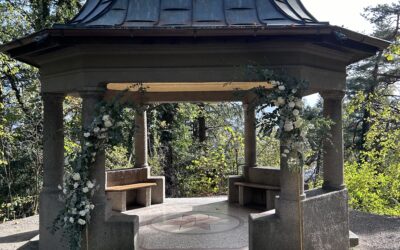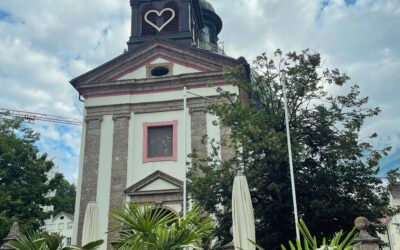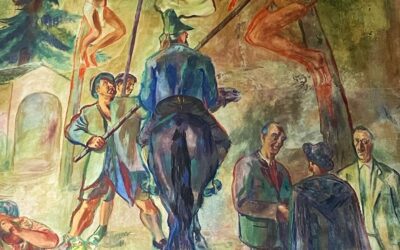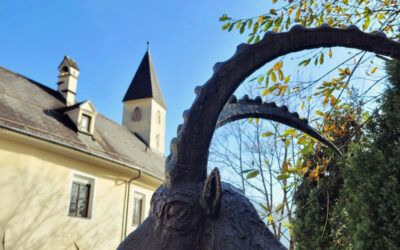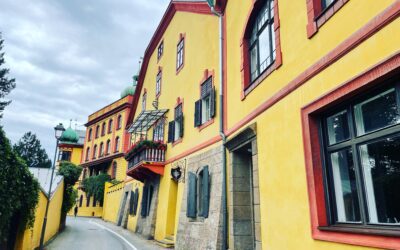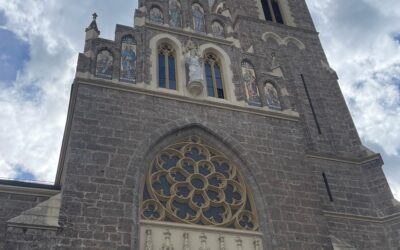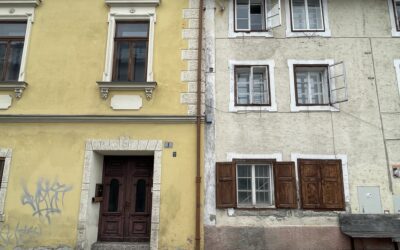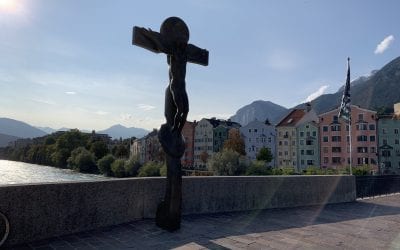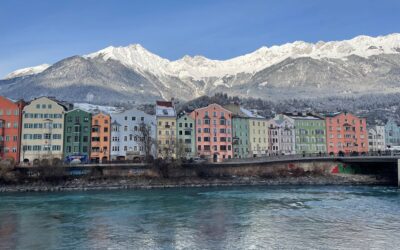St. Nikolaus, Mariahilf, Hötting and Mühlau
Interesting facts about Hötting and the Koatlackn
Wenn man so will, nahm Innsbruck im 12. Jahrhundert seinen Anfang bei den bunten Häusern am nördlichen Innufer. 1133 wurde in den heutigen Stadtteilen Mariahilf und St. Nikolaus von den Fürsten von Andechs ein Markt gegründet, von dem man in Urkunden als Ynbruggen spoke. As the town slowly moved across the Inn, the name "Inn" became established for the parts north of the bridge. Anpruggen. Even then, Innsbruck was an important hub for trade. A considerable proportion of the goods traffic between the German lands in the north and the northern Italian cities in the south travelled via Innsbruck. For a long time, the road led to the west via today's Schneeburggasse in Hötting, as the area of land in the valley, which is now the Höttinger Au, was a marshland. The Mariahilfstraße on the Inn was only opened up as a main transport route with the increase in trade in the 16th century. Silver from Schwaz and salt from Hall were traded along the salt road towards Switzerland. Until 1837, the main road through the Obere Anpruggen eine Sackgasse und offiziell als Obere Innbrückenstraße bekannt. Den Namen Mariahilfstraße erhielt sie von der gleichnamigen Kirche. Erst mit der Eröffnung der Kettenbrücke im Saggen im 19. Jahrhundert verlor die Mariahilfstraße wieder an Bedeutung als Verkehrsader.
The transport routes to the east led directly through today's St-Nikolaus-Gasse. For a very long time, St Nicholas was considered a wretched part of the city. It is no coincidence that the district bears the name of St Nicholas of Myra, as he was, among other things, the patron saint of those less favoured by life, such as prostitutes and criminals. St. Nicholas was home to everything that was not wanted in the city but was necessary for its functioning, such as the execution site, popularly known as Köpflplatz, and the penitentiary and workhouse. From the Middle Ages until 1789, the special sickhouse for people with infectious diseases such as the plague was located here. While the normal hospital was still in the immediate vicinity of the town, the infectious sick and the socially most vulnerable in society were kept further away from the centre. The Jewish cemetery was also located in St. Nikolaus am Judenbühel, just below the Alpine Zoo. The drinking water pipeline from the Nordkette, which was built under Maximilian in 1485 and fed Innsbruck's fountains, ran through St. Nikolaus. Innsbruck was very fortunate to have access to fresh drinking water from the nearby mountains. Until the drinking water pipeline was built, Innsbruck, like other towns, was dependent on the water in the fountains. The water was often stale and full of pathogens. It was not for nothing that beer and wine were considered safer everyday drinks than water.
The name Koatlackler für seine Anwohner kommt einerseits von den häufig überlaufenden Wasserleitungen, die die Stadt von den Bergen kommend versorgten, andererseits von Überschwemmungen und dem von der Stadt abgeleiteten, verschmutzten Wasser, das flussabwärts in St. Nikolaus landete, eben in der Koatlackn. Einen großen Teil zur Verunreinigung trugen auch die Metzger und die Fleischbank an der Innbrücke bei, die ihre Fleischabfälle im Inn entsorgten, der sie flussabwärts trug. Heute finden sich in den „bunten“ Stadtteilen Anpruggens, St. Nikolaus und Mariahilf, entlang des Inns viele Kneipen, Lokale und kleine Geschäfte.
Hötting was a village in its own right until it was incorporated in 1938. With its 8,000 inhabitants, it was one of the largest communities in Tyrol in the 20th century. The Allerheiligenhöfe and the Galgenbühel, next to the Köpflplatz at the eastern entrance to the city in St. Nikolaus, another execution site from days gone by, marked the western end of the community. Successful craft businesses were the reason for the self-confidence with which Höttinger confronted the city of Innsbruck. Economically, the village was on a par with the city for a long time. It was only with the development of the new Saggen district and the incorporation of Pradl and Wilten that Innsbruck finally overtook its often noisy neighbour from above.
The people of Hötting were always regarded as wild fellows. Höttinger children were considered bad company for the Innsbruck kids. In 1923, the newspaper reported:
"Recently, two pistols were taken from a 14-year-old boy in Schneeburggasse, with which he had allegedly amused himself by shooting sparrows. Shortly before, the dog of the tradesman Inwinkel had been shot in the square. The bullet penetrated the animal's head. As many children were playing in the square, it was fortunate that the shooting did not cause any major damage. The case is likely to have legal repercussions."
During industrialisation, workers from factories such as the Rauchmühle also settled in the village of Hötting. In contrast to the city with its employees in trade and administration, university professors, doctors and lawyers, craftsmen, gunsmiths, farmers and workers from the mine under the Hungerburg have always lived here. In the politically radical and heated climate of the interwar period, the village above Innsbruck was known as "Red Hötting". The Höttinger Saalschlacht of 1932, which enjoyed a legendary reputation in Innsbruck, also contributed to the neighbourhood's reputation as a hotbed of violence.
Das im Osten angrenzende Mühlau war bis 1938 eine eigene Gemeinde und wie Hötting für seine historisch gewachsene Industrie bekannt. Name und Bedeutung des Ortes entstammen den Bauernhöfen und Mühlen, die sich am Mühlbach schon im Mittelalter angesiedelt hatten. Dieser energieliefernde Bach war es auch, der Mühlau zu einer ersten industriellen Blüte verhalf. 1312 wurde erstmals ein Sagmeister erwähnt. Eine Plattnerei in der kunstvolle Prunkharnische hergestellt wurden siedelte sich im 15. Jahrhundert an, um die europäische Aristokratie, die sich in Innsbruck angesiedelt hatte, zu versorgen. Später folgten eine Metallgießerei und für kurze Zeit sogar die landesfürstliche Münzprägeanstalt, bevor im 19. Jahrhundert die Rauchmühle samt Elektrizitätswerk, eine Zuckerfabrik, eine Papierfabrik und Ferdinand Weyrers Betrieb der Gemeinde seinen Stempel aufdrückten.
Zu dieser Zeit war Mühlau auch Standort einer Kuranstalt. Was heute undenkbar wäre, funktionierte im Innsbruck des 19. Jahrhunderts. Wenige Meter von der Textilfabrik entfernt gab es mit dem Badehaus Mühlau ein Wellnesshotel. Innsbruck war mittlerweile gut an das Bahnnetz angebunden und leicht für Gäste erreichbar. Das Bergpanorama, das Gäste genossen, versprühte alpinen Charme, ermöglichte dem nicht ausschließlich an der Gesundheit interessierten Reisenden und seiner Begleitung, anders als in abgelegenen Orten wie Davos, trotzdem ein wenig urbane Zerstreuung zwischen den Anwendungen, wie im Magazin Der Alpenfreund 1870 zu lesen war:
"But if the alpine lover is blessed with a family, there is no need to worry about the possible nervous conditions and seizures of his dear wife or the scrophulic ailments of one of his children to prevent him from breathing out all the worries and cares and complaints of business life in the nearby mountains. He just takes his loved ones with him to Mühlau, leaves the healing confidently to the care of the owner of the aforementioned establishment, Dr Schlechter, who will know how to achieve his healing purposes with cold water cures, brine baths, gymnastics and electro-magnetism, and - walk confidently towards heaven on the mountains himself! (Note: quoted from sagen.at)"
Today, the Mühlau bathhouse is a residential building worth seeing that has been architecturally preserved in the style of the 19th century at Anton-Rauch-Straße 30. Today, Hötting and Mühlau are middle-class neighbourhoods where neither magnetic treatments are administered nor subversive dangers threaten.
Aviary & Pavilion Villa Blanka
Weiherburggasse 31
Pfarre Mariahilf
Dr.-Sigismund-Epp-Weg
Theresienkirche
Gramartstraße 4
Weiherburg & Alpine Zoo
Weiherburggasse 37-39
Turnus clubhouse
Innstraße 2
Büchsenhausen Castle
Weiherburggasse 3-13
St Nicholas Church & Cemetery
Schmelzergasse 1
Gasthaus Elephant & Gasthof zur Eiche
Innstraße 85 / 87
Workers' housing & Weyrer area
Ferdinand-Weyrer-Straße
Inn bridge
Opposite Innstraße 5 / Innrain 1
Mariahilfzeile & Marketplace
Mariahilfstraße / Marketplace
